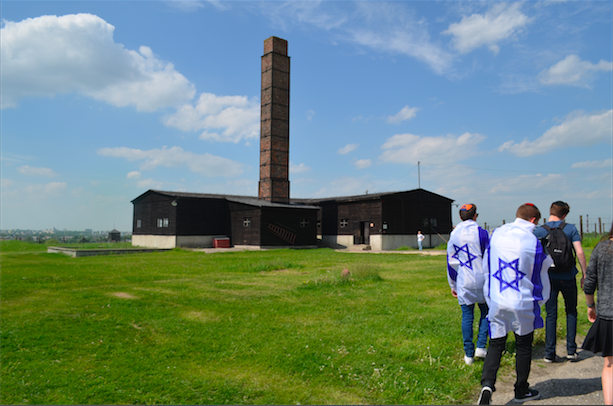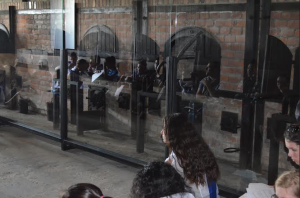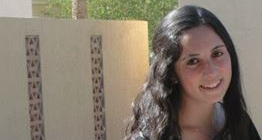Majdanek: Endless death in the heart of a city
SENIORS IN POLAND: Day 1
SMOKESTACK: Clearly visible from the surrounding city of Lublin, the chimney at Majdanek jutted into a blue sky in a scene of unsettling beauty as seniors on the Poland-Israel trip approached.
May 20, 2015
“With your permission, a quick moment of silence until we reach our final destination,” said Yonatan, our tour guide, en route to Majdanek. I didn’t think the moment of silence would last until we arrived at the concentration camp. Someone was bound to ruin the silent 20-or-so-minute drive, I thought to myself, as I stared at the yellow and red public transportation busses overcrowding the streets of Poland. There were schoolchildren holding hands crossing the street to get to school and adults completing their weekly shopping at the local fresh fruit market. Life was normal and the city was vibrant, as the moment of silence on the bus continued.
All of a sudden, about 45 seconds after Yonatan asked for quiet, the bus arrived in the still, yet scenic plot of land – Majdanek. It was covered with endless barbed wire and interminable watch towers. The tall grass swayed in the breezy and sunny day in the middle of May. Dark brown bunkers lined the fields and the tall chimney of the crematorium did not hide the Nazi secret of extermination. A massive pile of ash filled the monumental rock just outside of the camp and birds peacefully chirped as they flew around above us. It was strangely beautiful. But as the moment of silence on the bus was broken by curse words and deep gasps from students shocked at the sight outside the bus window, I started to cry.
For the first time in my life, after almost 18 years of Holocaust education, the millions of photos and thousands of videos I had seen became a reality. It was no longer a black and white stream of evilness rotating across my TV. It was no longer a resentful thought in my mind based upon stories I had heard from survivors. The death camps and labor camps were real. They existed in the middle of Poland. In the heart of a city.
I thought to myself: what would be if I arrived at the camp just 70 years earlier. Would I survive? Would I be tortured? Would I ever see my family again?
To my surprise, Majdanek was a colorful camp lined with green trees, brown buildings, red and orange shoes, blue gas stains and purple flower buds. It was not a camp located in the middle of the forest, but rather in the heart of Lublin. The beauty contrasted with the historical disgust of the place.
As we walked into Majdanek, our teacher Ruthie Skaist handed out Israeli flags. I grabbed one from her hand and wrapped it around my body for protection. Inside, we began to follow the story of Helene Birnbaum. She was a 13-year-old girl when she arrived in Majdanek with her mother, but they were quickly separated as she went to the showers and her mother to the gas chambers.
Standing at the selection barrack where Helene Birnbaum and her mom were separated, I noticed a park adjacent to the camp. A woman walked by with her black lab and red leash continuing her daily life. A group of men jogged by in neon colors and trendy Nike shoes. Strange. How could the death of 360,000 Jews have taken place in the midst of a city? How could the Polish bystanders have let this happen? Why did the prisoners not run away to Lublin?
So many questions flooded my mind as I continued to somberly follow Helene Birnbaum’s path. We walked through the clothing swap station, where Helene records her older cousin taking care of her after her mother was killed. She was forced to strip naked in a room full of woman who did the same. Her older cousin was brave enough to steal a nicer pair of shoes, but Helene would not resist against the Nazis.
We continued in the same building to where Helene’s mother took her last footsteps – into the gas chamber. There were two rooms. Both are still equipped with gas that can turn the room into another death bed in seconds. The evil inside again contrasted with the beauty outside, the green tall grass and shining hot sun.
Next, we followed Helene’s footsteps around the camp. First to a barrack lined with thousands upon thousands of shoes. Each shoe revealing a different story, representing a different individual Jew, all lost during the painful war. Then to Barrack 14 filled with triple-decker bunk beds that squeezed 500 people into a max capacity space of 150. It was too hot for me to even remain in the room. I can’t imagine what the inmates experienced in the middle of summer.
Finally, we walked through the remnants of Area 3 and reached the crematorium, the last stop within the physical camp of Majdanek. Uncomfortably, we began to sing. In the middle of Majdanek, we sang. We belted out Ve’Zakeni Legadel, Achenu Kol Beit Yisroel and Ve’Hi Sheamda as one cohesive family. Some continued to cry. Some flashed smiles across the room. And some remained silent, still in the shock of our two hours spent inside the camp.
BP Photo by Goldie Fields
GHOSTS: Gazing into the walled-off ovens of the crematorium, seniors’ reflections in the clear barrier connected the present with the past.
At first, I felt uncomfortable singing in front of ovens built to wipe out my people, to destroy the Jewish nation forever — especially after the experience I underwent when walking through the camp. But the warmth of the voices that surrounded me and familiar echoes bouncing off the concrete walls of the room encouraged me to slowly join in. As we sat there and sang, I reminded myself of just how blessed I am to be a Jew. Hitler tried to destroy us, but we survived. And there was no better way to express my amalgamation of emotions than sitting in a circle with my arms around my closest friends and teachers, singing our ancestral songs.
Majdanek was a heavy first site to visit. But an important place to see — one that fosters strength, positivity and optimism. Am Yisroel Chai. We are here.
This story won a 2016 Gold Circle award in First-Person Opinion Writing from the Columbia Scholastic Press Association.















